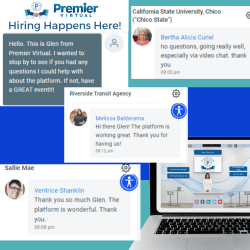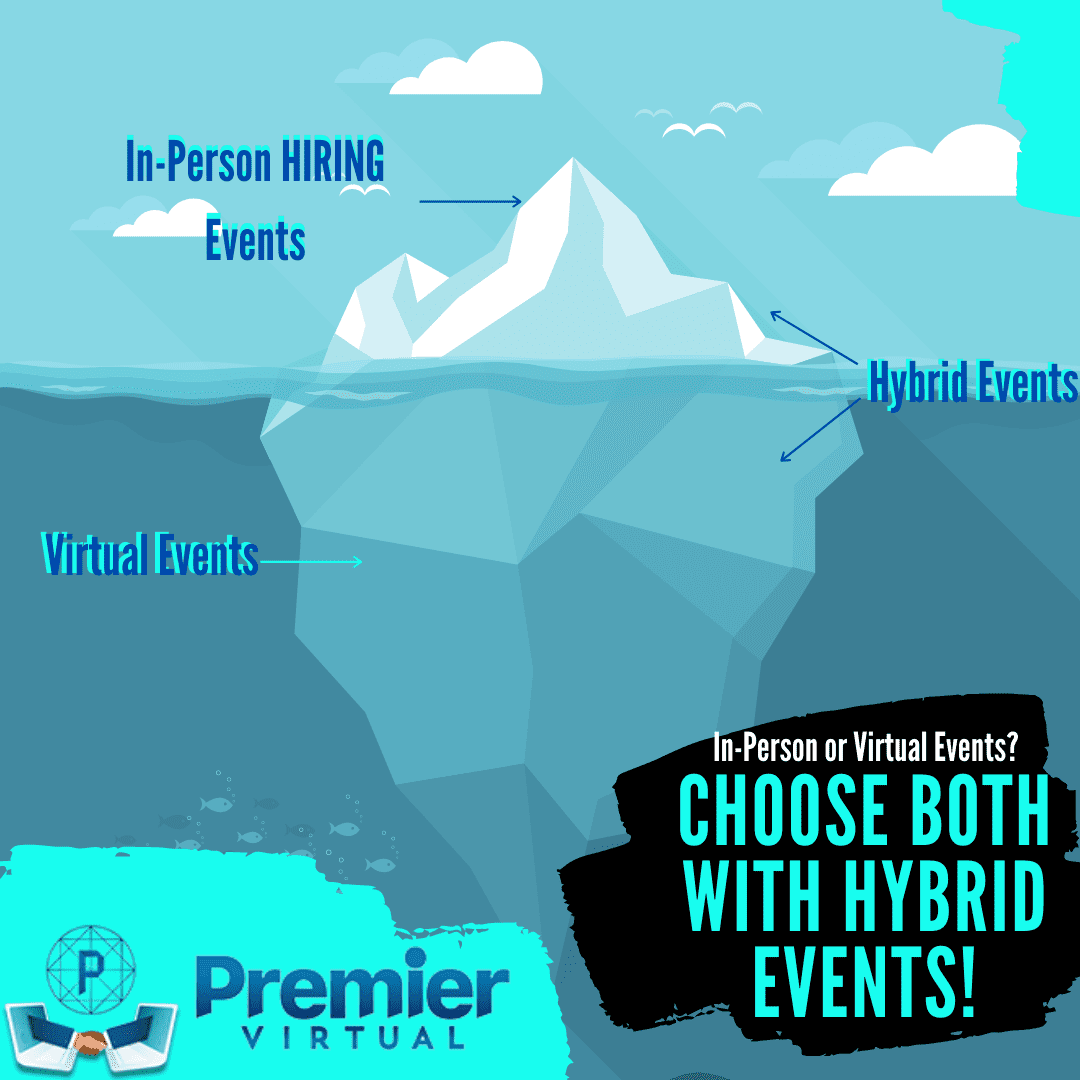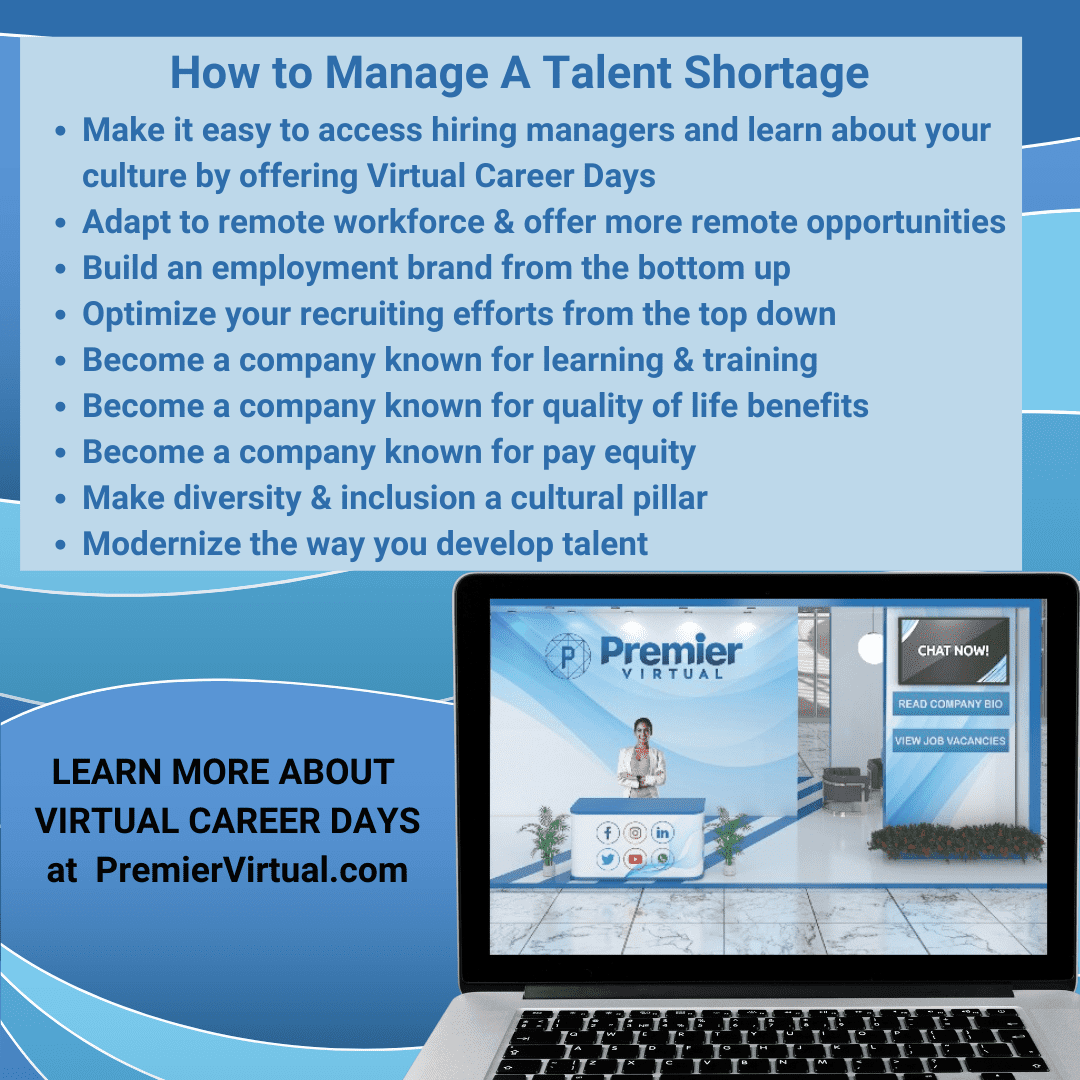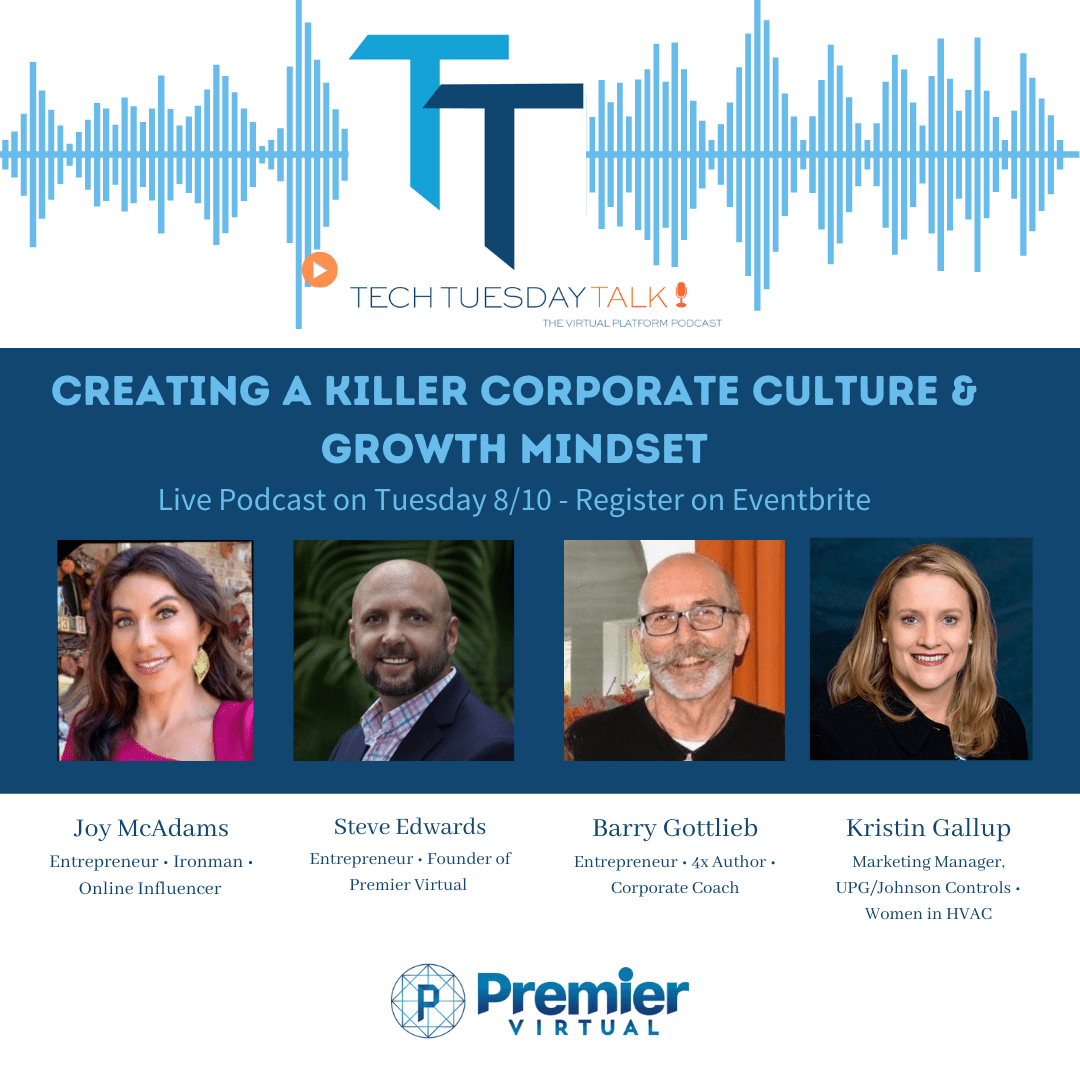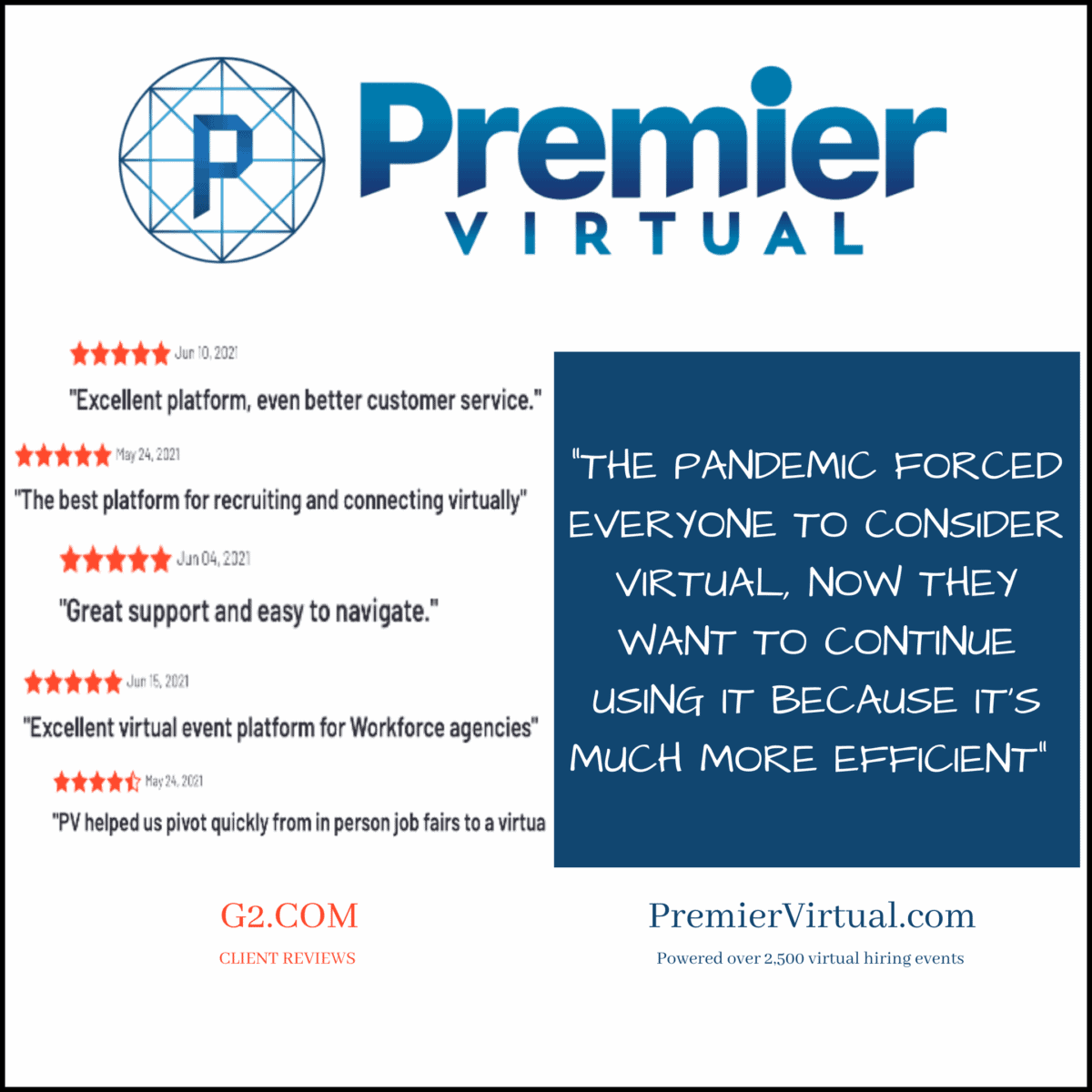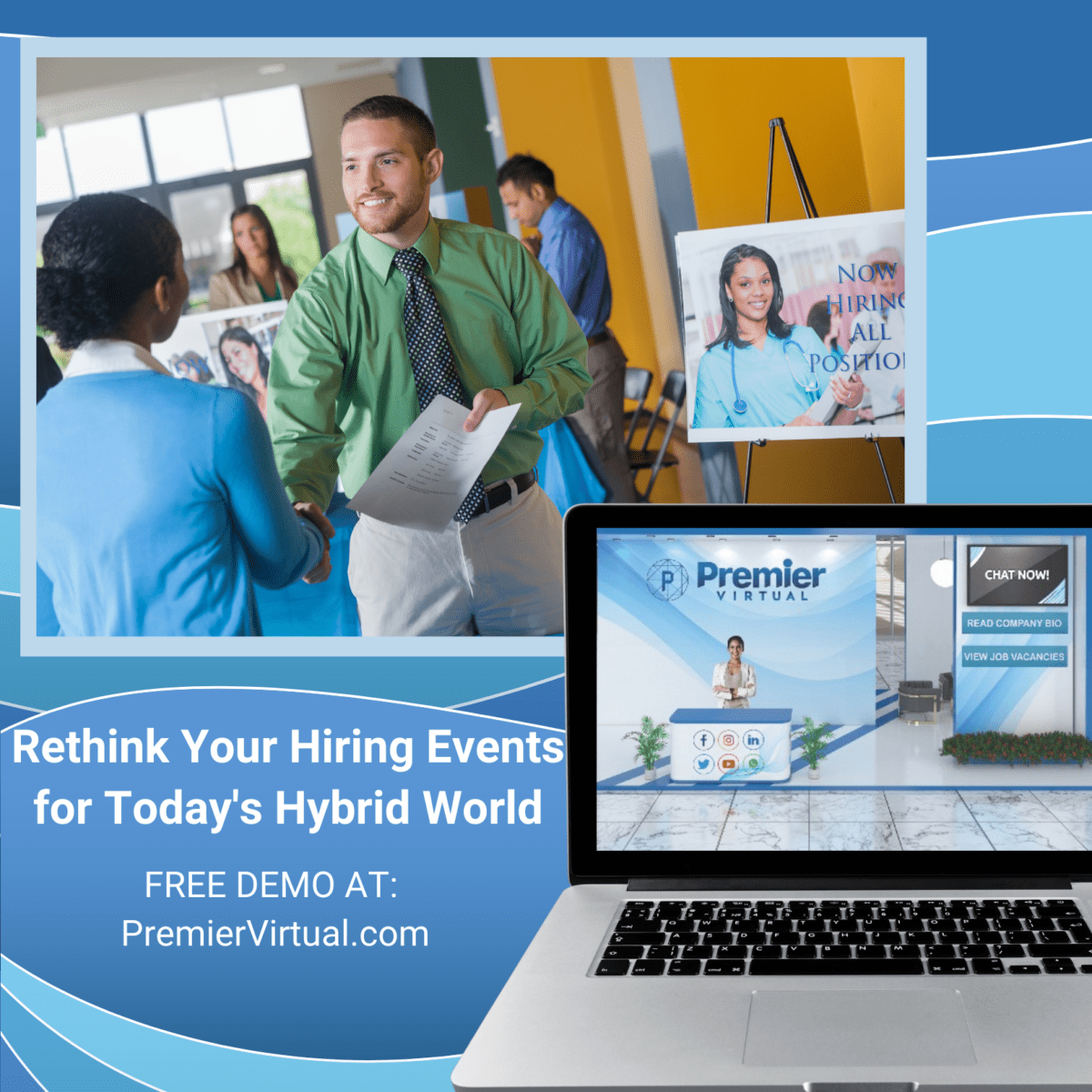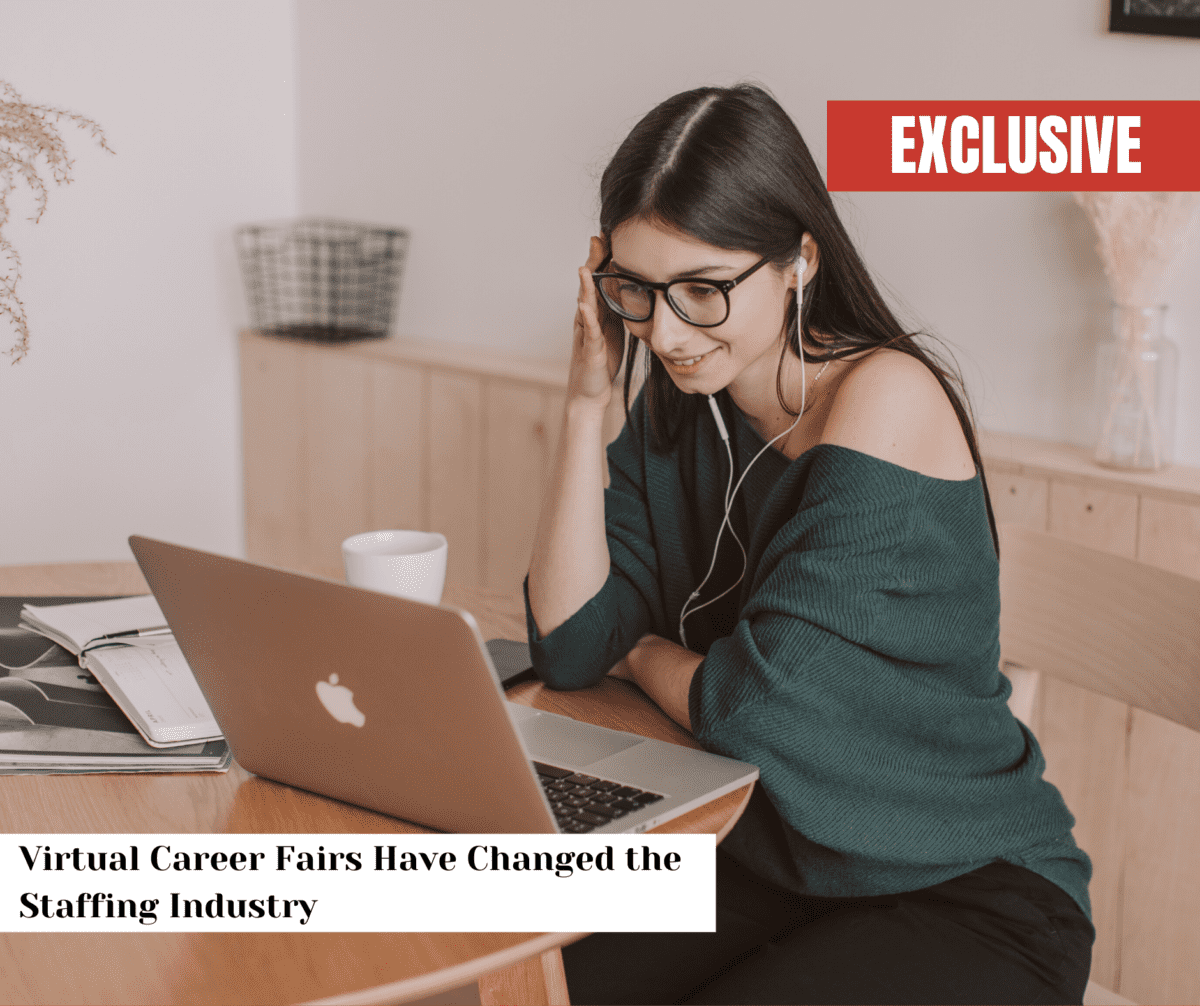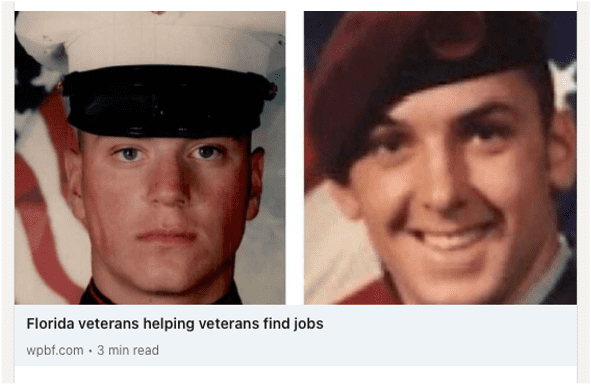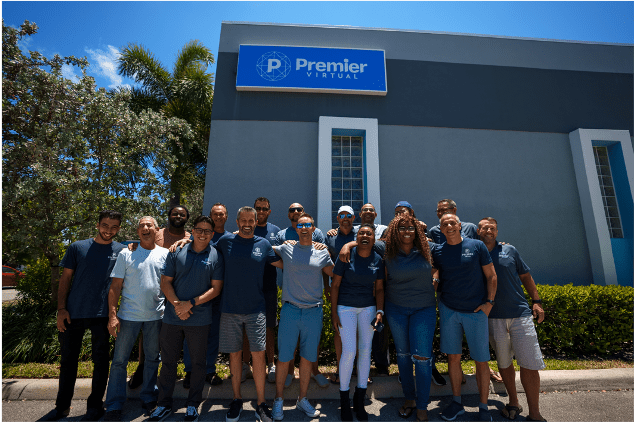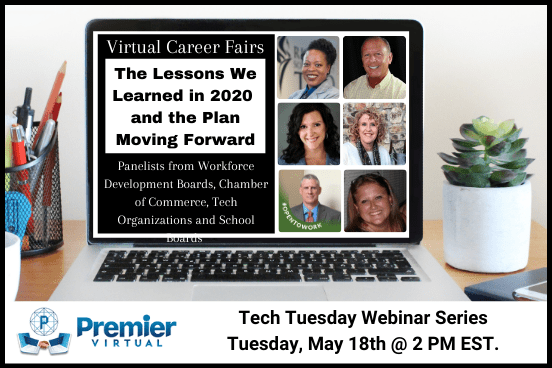Here is the transcript of the Tech Tuesday podcast from August 10th. Lots of great value bombs from our host, Steve Edwards, and our panelists: (Please note: this was transcribed from the audio which is why you will find inconsistencies in grammar and punctuation).
STEVE: All right, welcome, and thank you. We’re thrilled to have everybody join us today. Tuesday is the scheduled video panel discussion that we turn into a podcast. We have some great panelists here today (to discuss corporate culture and a growth mindset). Sometimes staying on top is just harder than getting there. We’ve all seen companies go from startup success, but (how) often have they been able to sustain that or not get there? So we’re going to start with our panelists, introduce themselves.
My name is Steve Edwards. I’m the CEO of Premier Virtual. We are a startup that is here in Delray Beach, Florida. But we’ve been around in business for 10 years as we switched over our business model two years ago to virtual. And here we are now in 2021 where virtual is the new norm. So let’s start with Kristin Gallup, she’s a marketing manager at Johnson Controls and involved in women in HVAC. Kristen, can you give us a quick little introduction of yourself?
KRISTEN: Sure. Steve, thanks for having me. I am an innovative marketing professional who helps our contractors grow their businesses. I have spent, gosh, the last 14 years in various marketing and operations roles with several Fortune 500 companies. So thanks for having me, Steve.
STEVE: All right. Thank you. Welcome. Next up, Barry is an entrepreneur for time author and corporate culture. Barry, can you give us a quick little intro?
BARRY: The quick intro started out as an educator, became a school principal, became a teacher at Santa Fe Community College, then at the University of Florida. And then I gave that all up to enter the business world. A long time ago, my partners and I built a very, very successful seventy-five million dollar company that we sold in nineteen seventy-eight. Since then what I do is, I do my best to inspire and empower others to reach their full potentials, whether they’re individuals or companies.
STEVE: All right, well, welcome. We have one more panel that will be joining, she’s not logged in yet, but I’ll join in. Joy McAdams is an entrepreneur, an Ironman, and an online influencer. So let’s get started. Let’s start with Kristen. But, you know, obviously, with all of the questions, I want the panelists to be able to be open and kind of talk about them as well. You know, Kristen what role does brand identity and corporate culture play in hiring decisions?
KRISTEN: It plays a huge role, so it’s not just about the monetary job or the financial benefits of the company culture is it really has become a deciding factor for many candidates. Right. When you think about companies with strong brand identities and welcoming, corporate culture helps to attract and retain top talent. So candidates who are looking for companies that are progressive and they display understandings of the organization’s core values and their vision during the interview process are probably more likely to be long term employees.
So but I would say the biggest thing is your employee is your best friend and ambassador’s rank. They go all-in on the corporate culture and they extoll the virtues of the organization in all their encounters. So when you think about a corporation and its culture and how costly attrition can be, it’s really vital to have your organization’s company culture seen in a positive, healthy, and clearly communicated light as part of your hiring strategy.
BARRY: Yeah, and I would say I would jump in and I would say Kristen that everything you said is spot on. You know, when I think about it, when I see corporate culture, I look at it as a reflection of what the organization actually stands for. It’s sort of a voice for your business. And in today’s world, it isn’t just whether a candidate can come on board and do a job, it’s whether or not they fit in with that culture that’s been created and a strong, positive culture.
Certainly, as you were saying, you have a much greater chance of retention.
KRISTEN: And wouldn’t you say, Barry, that it’s a constant evolution like as you’re forming these cultures, it’s forever changing?
BARRY: I would hope so, because, you know, back in the day when my partners are building a business that was better than people would think about a five-year plan, a ten-year plan, and but that has changed dramatically. I think that that in today’s world, it’s all about change. Jack Welch once said a long time ago that whatever got you to where you are today, that’s not enough to keep you there. And so I agree with you.
And just like companies have to be agile and shift, I think that the culture also has to be agile and shift. I think that we’ve gone from the Industrial Revolution to now, which is all I think any corporate culture of positive corporate culture has to be about humanity. It has to have a strong why as to why those people want to work there, why they are working there, what they can do to contribute. So I’m one hundred percent agreement with you.
It’s always changing.
STEVE: You know, I think the same thing, you know, and I was actually another thing I want to talk about is work our culture and we kind of got to that a little early. But, you know, how do you think a company can build their brand and build their culture? Because we know so many organizations struggle with that. What do you think? Kind of throw it to you first, Barry. How do you think a company can create those two things?
BARRY: Well.
Let’s start with this and it starts with the top. OK, what’s the vision, the values of that person that has started this company? And then when you take it from there, it’s you know, and a leader in a company is either a man or a woman. And they have this incredible vision, but they also have the ability to articulate that vision so powerfully that everybody on the team gets the same vision, and so I think it’s strongly it’s about trust, it’s about humanity, it’s about communication, it’s about collaboration.
And it’s and it’s as Kristen said, it’s about being agile and being ready to change because things change as you go. But definitely, the corporate culture starts from the top.
STEVE: And how important do you think it is to be ranked in a top place to work for?
BARRY: I’ll jump in and tell you that companies that have been voted best places to work outperform people in their industries on an average of 20 plus percent. So, I mean, I’m one of these guys that loves all the good stuff, but I also like bottom-line stuff. And when we talk about a 20 percent increase in productivity and customer satisfaction in money that is returned to the stakeholders, not specifically just the shareholders. And oftentimes companies get I think they lose sight of who they should really be working with.
And for it’s about the stakeholders. It’s about all the employees that work with you. It’s about all of your customers. If you take care of all of those stakeholders, then you don’t even have to worry about the shareholders because the shareholders are going to get that return on their investment because you’re taking care of the stakeholders.
STEVE: And a lot of that taking care of the stakeholders takes care of the shareholders. I’m stealing that line, Barry, I love you, man. We talk about that a lot here. And, you know, when my business partner and I, when we built this organization and we went through back in twenty eighteen, we were a company that put on the in-person job fair. So we were doing that for nine years and we were very successful and we loved it.
But things were changing in the world. So we had to kind of look at something and we switched our business model from in-person to doing virtual events. And then we switched our business model again back in twenty nineteen instead of putting on events to license our software. So it was two big changes, but we went from a very small organization to now we have 30 on our team here and culture was very important to me right in the brand identity was out there and we’ve tried to build a culture and you talked about it from top-down.
It’s kind of our vision, my vision, Gary’s vision down to everybody that we hire in just in the interviewing process that we have. And we built the new office here in Delray, and the first thing I did is I ripped out the conference room and I put a gym in there. So we have a beautiful gym. So when people come in, if they want to work out, they can work out. Then we went in and we built a beautiful shower in there.
So now people want to come in early. They want to stay late. It’s just little things that we have. And I mentioned the thing about working for and you get a lot of these great emails out there about different things to be involved with. Well, Florida Trend magazine, we just got ranked as one of the top 100 places to work for. We were number 16 in Florida to work for, and that was very important to us because of the surveys that our team got ranked us where we’re at.
So we feel that as the recruiting, our brand identity and being able to have that culture fit is very important to just us individually. So I’m glad to hear kind of what Kristin and Joy, what you both said is kind of my mindset as well.
KRISTEN: So and Steve, when you think about how many hours you spend at your job, you spend in some instances more time on your job than you do with your family. And so that’s why it’s super important to have that positive culture.
STEVE: Absolutely. And, you know, take covid political-religious people to have different thoughts about everything out there. But when they come in here, they come in here to work. Right. And they come in here to have fun. And, you know, it’s one of these things that I look at it. And when I heard this the other day from the manager at my age and he’s like, you know, people in our community, they have different beliefs and they do not like each other.
But the one thing that they all have in common is that they want their houses to value to go up. And I kind of look at that. When he told me that, I said, you know, that’s kind of the same mindset at work, too, is you can have different beliefs and everything. But when our team comes in here, they have one goal in. Our number one goal is to make our clients happy. You know, Barry, you talk about stakeholders, and I believe as you make your clients happy, you never have to sell.
You know, and we do so much for our organizations that are our clients as well, because that’s such a key, key thing, like you talk to stakeholders and everything.
BARRY: So, Steve, I love to throw something in there. Look, I love what you’re doing for your employees. The fact that they have a gym that you put a shower in, that’s a great benefit. But I will tell you, those added little benefits, in the long run, that’s not what’s going to keep people there. It’s not going to be the ping pong tables, the foosball tables, the snack bar, the showers, the gyms.
It’s going to be how we treat the people that work with us. It’s going to be about what we accept in the workplace, because as leaders of companies, as managers, if you want to have a great company culture, people need to know what your values are. If you don’t ever state your values, you really are not telling them what the why is. Why are you doing things the way you do? Why do you believe the things that you’re doing?
Why should we do things this way? Why it matters what we do. Too often people hire a new employee and they tell them, here’s what your job is instead of telling them, here’s what your job is, here’s how you do your job. We’re going to help you if you have any challenges along the way. Here’s why. Doing your job right has a huge impact. I mean, look at your company. Thirty people, each person on your team.
The reason it’s one of the main reasons that what they do is or why is that they’re not just responsible for them. They’re responsible for the other twenty-nine people in their families that work with you. And then, of course, I think that in business. We always have to understand that no matter what, there’s we have to measure the execution of the plan. And Christian, I would love your feedback on this because I’ve always had a philosophy and my and my company, because I learned a lesson the really hard way, is that sometimes we have somebody on our team.
And I’m going to give you my example. We had somebody that was our number one salesperson in the United States. This person, unfortunately. Created a really nasty habit of abusing substances, and so this person would show up at work every day and they do a great job for four hours, then they would pass out and I would have this conversation with my partners that this doesn’t go along with our values. This doesn’t go along with who we say what we are.
My partner going, no, you can’t fire her. You can’t fire her. Well, we tried to get her help. We offered counseling. All that never worked out. Long story short, we let her go, even though she was our number one salesperson and our sales skyrocketed after she was gone. So it’s we have to understand that the people that we hire, 95 percent of our success are who those people and as leaders in creating a corporate culture, we have to make sure that we are living that culture, those values that we profess to have in our business because if we don’t, the employees see through it.
And if you look at the statistics, sixty-four percent of employees feel that their companies don’t have a good corporate culture. And when you don’t have a good corporate, good corporate culture, what is the bottom line to everybody else in the company? Well, basically, it’s about 30 for the cost of a disengaged employee is 30, 40 percent of their salary. So we’re having a culture where you take care of people, you promote the people, you value, the people.
You tell them what they need to do, how to do it, why they’re doing it, and measure what they do. You end up having a culture that survives and thrives. Rather, it’s all these things, not just those little perks of like a shower or a gym and all that. So I just share that with you. That’s my experience.
STEVE: You’re 100 percent right. I mean, it’s more than that. Those are little small things out there. But it’s, you know, getting the people together, getting people to respect each other as well. So there’s so much more than just the gym. You’re absolutely you’re 100 percent right, Joy. Welcome, Joy. But can you give a quick little 30-second intro to who Joy is?
JOY: Sure. And I was excited about the gym, but I thought that was awesome. That’s great that you guys do that because I think it shows that you care about, you know, the advancement and the growth of your employees. So, you know, there are so many great points here that Barry made as well. So anyway, not sure what happened when I was just trying to log on here, but I, I work in the field of medicine.
That’s my business. I help achieve a growth mindset for medical practices to help them grow, increase their patient volume and all that type of thing in tech is a big part of, you know, making giving them that patient satisfaction as well. I’m also an Ironman competitor, so really big on endurance and pushing your body and mind to continue to grow. So all of that wrapped together. I, I love stressing the growth mindset.
STEVE: So before we get anything else, just tell me, Joy, what’s it like to train for an ironman?
JOY: It’s it’s challenging. It’s challenging because it’s you against you and it’s really you against your mind. And so much of that has translated over to help me as I’ve grown physically, as I’ve grown mentally. It’s helped me professionally as well, because that same grit, determination, you know, pushing through the pain that we’ve all faced in building a business, you know, facing the struggles, especially that COVID threw our ways at all. You know, it all comes together if you can put that in yourself. And nothing challenges you more than physical. You can’t you can’t escape that. You have to step up to the plate.
STEVE: I love that. Are you against your mind? You know, I say people every morning you have a choice. You wake up and you have a choice. Are you going to work hard or are you going to be lazy? And I think people have choices to be able to do that. So great to hear that. You know, Joy, quick question. How do you make it relevant to different generations in one workplace?
JOY: Being willing to be encouraged that that diversity and the curiosity and the different perspectives, I think like like we were saying, you know, the growth mindset has to come from the top. And if you have someone at the top that is set in their ways and is not open to this next generation and their ideas and their ways of doing things, there’s going to be an issue. I know it’s more than one word, but it’s I think just encouraging that that diversity and thinking and approaches
STEVE: You talked a lot about workplace culture. What do you think is the number one thing that an organization I’m going to ask all three of you, this is the number one thing an organization can do to create a great workplace culture.
BARRY: Probably just one thing, I’m going to go with psychological safety for the people that work there.
STEVE: OK, let’s dig into that a little bit. Tell the audience out there. What do you mean by that and how would they do that?
BARRY: People, I believe, want to be in a place where they’re not going to be bullied. They’re not going to be shut down, where they can trust the leaders, where the company’s values and the people that work there have integrity. And I may have I don’t know if I said it, but I’ll say it again. Honesty is key. Transparency, communication, collaboration. So when you have psychological safety, leaders in the company are making it a place, a safe place for the people that work with them to be able to speak.
Not just to the leaders, but to anybody in the company that they’re respected for, who they are, what their contributions are, and they understand that there’s not just one way to do things. You know, the worst thing that a company can say is that’s not how we do things here. OK, because if that’s your mindset and I know the Joy’s great on this mindset. And by the way, Joy, you jumped in just a little bit after.
I’m all for gyms in the workplace. I, I had one in my business. I just I’m just saying that’s not all we need to have a great company culture, but mindset’s what it’s all about. And I think we have to create a place where we invite, we inspire. We empower people to speak up, to feel safe, to say and try things, to be willing to make mistakes as long as we learn from them. You know, anybody and everybody makes mistakes.
It’s whether we learn from them. If you make the same mistake over and over again, that’s a choice. All right. But everybody makes a mistake. And so I think psychological safety to me is the key to creating an amazing company culture where people literally feel safe, where they work and they trust you.
STEVE: And that is great feedback, thank you for going a little bit more into detail and to touch on what you said previous to that, you know, getting rid of the top salesperson. How difficult was that when you had to make that decision?
BARRY: Well, going back to the psychological safety, it becomes a thing of if you have this one salesperson, one person on the sales team, out of twenty-one salespeople in this person’s coming in every day and passing out because of the drugs that she abused the day before, the night before. What is the message that I’m sending to the other 20 salespeople? What’s the message that I’m saying about the values that we stand for our guiding principles that we stand for?
And so was it difficult? Yes, because my partners, all they saw was the money that this person was bringing in. And my view of it was it’s my job to do everything that I can do to help this person. But if they refuse to accept that help, I mean, we offered for her to go check herself in for three months. Her job will still be there, will still pay her. She wouldn’t take it because she said, I don’t have a problem.
My belief is that every company has a bad apple in it. Sorry, OK. But I do believe every company and they’re very they’re well hidden these bad apples. And there are people that really don’t believe in the company culture. The company values the why of the company and they behind the scenes are trying to get people to see things the way that they do. Allowing somebody that is passing out of their desk every day and doing nothing about it. It was a very bad message to send. So in the end, it was a very easy decision
STEVE: And that’s why I wanted to tie it back into what you said about psychological safety. You know, it seems like you’re catering towards the one person that top sales rep. And I think every organization goes through that and they have it. But you’re affecting all of these other people. And what happened as soon as you let that person go, your salesman because now you’re protecting those other people that are out there and you’re doing the right thing for everybody else.
So, Kristin, what about you? What do you think is the one thing that you would say that could help organizations improve their workforce culture?
KRISTEN: So my first one was a safe environment as well, so, Barry, thanks for covering that. But I would say the second thing is listening and seeking to understand because I think a lot of times employees voice their concerns or they’re trying to understand the culture and they ask questions. And depending on where somebody is, emotional intelligence is or the lens in which they’re interpreting what somebody’s saying, I think that there is sometimes a breakdown in communication. So it’s asking the right questions to make sure that you understand what those challenges are and how they can help form that culture and work through those challenges.
STEVE: Now, you said listen and seek to understand, and we know the way that people can be talked to. Different generational ages will say, how do you think where you know, I don’t say if it’s right or wrong. I have people that work for me that are all ages right from twenty-one years old, up to mid-50s. So to me, that doesn’t matter. I listen to everybody, but a lot of organizations have a challenge with millennials and Gen Zs that come in and say, you have to do it my way.
How do you think an organization can work with the different aspects of the age and still be able to listen and seek to understand and build a good culture?
KRISTEN: Yeah, so I think it’s about embracing the differences because you’ve got baby boomers, the Gen Z or the Gen Xers, the Millennials. And like you said, they all communicate in a different manner. And so I think it’s it. I think it’s you need to take a look at the employees as individuals and I think, you know, fostering your communications to kind of curtail to how they interpret things or how they, you know, how they communicate helps with shifting their mindset, right?
So you’re not going to attack, you’re not going to attack communication with a millennial the same way you would with a baby boomer, because, again, they’re interpreting it from a different lens.
STEVE: I see that in the way that I can talk to my development team, in the way that I can talk to my sales team. I have to talk in two completely different ways.
KRISTEN: So this is tone, right? Sometimes it’s the tone or how you ask a question and it’s the way they interpret it. Like if you’re you’re questioning how they’re doing something or maybe there is a better avenue in which they should do it. I think, again, it goes back to understanding your audience and how they communicate and sometimes curtailing that message so that they understand what needs to be executed.
STEVE: Well, understand the audience. I think that is key. So, Joy, what do you think the one number one thing is to kind of improve the workplace culture?
JOY: I absolutely say flexibility, and I think that is in. Cut big way. And when you see that healthy collaboration, because there’s no such thing as balance but a healthy collaboration between our work, family life, and health, they are going to be so much happier. They’re going to be so much more productive and ask any mom. I mean, she would be more than willing to work an extra hour or two if it means she has the flexibility to be at that school meeting, to be at that school field trip, you know, that type of thing.
They’ll bend over backward if they know that they can be at those things that are important. And it just makes for such so much more productive because you know, that, like we were saying from the top, that it also has psychological benefits, big ones as Barry referenced. So I think that for me would be one of the biggest ones.
STEVE: I’m going to go completely off topic right here because you mentioned it. Right. Like, I know my wife wants to be there for everything, for my kids and stuff like that, and she’ll do exactly that.
Remote work in office or hybrid? What are you seeing out there and what do you see as kind of the future of that?
JOY: I think I really like the hybrid because you still need to be able to come back together. There’s nothing like face to face. There’s nothing like that team, you know, having that team and, you know, even Zoom can’t quite capture that. We just recently had a conference for one of my clients. And just to be face to face, there’s a huge difference, even though we’ve been doing Zoom calls for months now. But I think a hybrid is a good balance of that.
STEVE: I love that you said that kind of leads in, you know, Barry you’ve owned some companies. You saw the company. You know you sold the original company in 1978 before Zoom was around. But how do you see Zoom as building a culture? Can you build a culture around Zoom and those types of virtual events?
BARRY: This is sort of a trick question, isn’t it?
STEVE: Right. So that’s what I’m here for. I’m not here for the software.
BARRY: If I take my magic crystal ball, what I’ll say. First of all, I’m in agreement with what Joy said. I, I think that’s sort of a blend, you know, where there are people who can work from home as well as being the office. I think we have a natural tendency as human beings to like that interaction face to face with other human beings. I look at my wife who works for this major corporation, and she’s been working from home now for well over a year and a half, and she works longer hours than she did when she went to the office, you know, so if you’re dedicated.
But I think it would be a great relief for her if there were those days where she had one or two days, three days a week, where she’s in the office and she has that human interaction. So what do I think about Zoom for creating cultures? I think it takes a lot. It’s going to take a lot of work from leadership to make that work. And I think what I mean by that is that it’s not just assigning to people what they need to do, but I think it’s also making sure that you’re giving people the chance to express their challenges.
I have this big belief, whether it’s in your office or whether you are virtual. I believe that what leaders need to do is have to have these what I like to call impact meetings and the managers in each department. So if you are a manager of sales, that manager should have a ten-minute to 15-minute meeting with each of his team, whether it’s virtual or in-person every week. Find out what their victories are, find out what their challenges are, find out what they’re going to focus on for this next week and when we can create that.
And then each of those managers then reports to the VP or the CEO of the company. I think that there needs to be if you’re going to create a culture that strong, that’s partial, virtual, or all virtual, there needs to be more this one-on-one, not just these group team meetings.
STEVE: Great point, and I think that organizations are seeing that and a lot of people are going hyper when covid hit with us. I sent everybody home immediately.OK, go home, work from home. Some people made it. Some people and some people wanted to lay on the couch all day and lay in bed. Those are not people that are going to be successful wherever they’re at because they chose not to be there. And now we try to have the zoo a happy hour. A couple of weeks ago, I actually had them go on. I partnered two people up that normally wouldn’t be together because they’re different, different backgrounds.
I partnered them up together to build a murder mystery on our platform. So it wasn’t something that was just that, hey, let’s all have drinks and ask questions and tell stories. It’s doing something together and bonding more because it’s very difficult when you have a remote workforce and some people are not in the state. So I think that it’s a good thing about I’m a face-to-face guy. If you would have asked me five years ago, Steve, would you be running a tech company that runs virtual events?
I’m like, no, I like to be face to face. I like to be one on one having those conversations, but you had to change with it. So I think that you can use Zoom. I don’t think it’s the greatest thing out there. And even on the trade show side, I’ll say it. There are certain trade shows that are better in person. But now with everything that’s going on out there, how do you make that into a hybrid aspect?
STEVE: Again, it starts with the workplace, people wanting to be there. So Kristen will or actually, you know that I ask Kristen and I ask you yours now. Yes, I did. I did. Sorry. I got to talking and I missed where my question was.
OK, we’ll start with let’s start with Barry on this one. Can a growth mindset within a company, because you have different fund sales, develop marketing all its can a growth mindset cause division within an organization, or is there a possibility to be able to leverage it to unify and really get the team to work together?
BARRY: The simple answer to this is that for every department in a company, you should hope and pray that they all have a growth mindset. If it creates a little bit of competitive nature or a divisive thing, that’s leadership has to find ways to make them find a way to work together, to share ideas, to share ideas. But you want everybody, the thing that that troubled me the most from covid were the clients that engaged me and all they wanted to do was survive.
And the first thing I said to them was, look, survival mode. I can already tell you the outcome. You should always be in success mode if that means that you have to pivot to do something different. And focus on how do we succeed even in this look, I understand it may be tough for a restaurant where they no longer can be open without clients, but I’m talking about corporations that are running or people that are solo entrepreneurs that have a few employees with them.
I think that what you have to be doing is always be focused on a growth mindset. And that means when pardon my language, but when the shit hits the fan, let’s not go into survival mode because survival mode means we’re just barely going to get by. Let’s figure out how we stay in success mode. How do we shift? Because shift happens. If you put enough pressure on people, the shift will happen. And what we want to do is we want to get people to shift.
All right. So these are the challenges. What do we do? What are the possible solutions. Too often what happens in companies people get stuck in to condemn, criticize, complain, or that damn covid? Oh, you know, so-and-so. Does that get you nowhere? Condemn, criticize, complain, get you nowhere. Yes, you should identify challenges, but you have to be a solution-oriented company. And along the answer to your thing is, look, I think every department has to be growth mindset charged. They just have to always be thinking how do we invent a better mousetrap if it ain’t broke…break it!
STEVE: I like that. Now, do you going off of that? Do you have your teams work together on a growth plan or and bring it to the leadership, or do you ever put all of the teams together, maybe one or two people from each one of the teams, and say, where are we going next?
BARRY: Well, for me in the past, because we had four hundred and fifty employees in Miami, three thousand in South America, the idea was obviously I couldn’t put them all together. But that’s you know, that’s up to the managers in each area to get that feedback, to have the collaborate with the people that work with them on the teams, take the best of the information, bring the managers together, and then we would all get together as leadership teams to discuss the different ways that we can grow the business.
You know, what is production say that we can do to make things better? What is logistics? Say that we can do what a sales say that we can do. What is marketing say that we can do? What what are the strategies, the solutions that people think of? And then what you do is you take all these solutions and you figure out, OK, which one is which two are going to be the ones that we are all going to accept and move forward on.
STEVE: Great. Thank you, Kristen. How do you create an engaging experience in the workplace that is not cliche and raises inspiration within the teams?
KRISTEN: Yeah, so I think you want to select activities that appeal to your employees so that they can take ownership and strengthen their commitment to the organization and their team members. Right. Because everybody is a stakeholder in the organization. And so I think know not using your typical buzz words because we do in culture or organizations that focus on culture have their specific buzz words. And sometimes those buzz words do not resonate with employees. And that takes them further from the culture that you’re trying to build within the organization.
STEVE: And do you get that like have a team that kind of builds some of that stuff, or is it more of, you know, the leaders choose what they’re going to do? How do you work that?
KRISTEN: Actually, within Johnson Controls, they’ve really been focusing on our organizational health and every single facet that ties into the culture. And so there was a company-wide initiative to look at videos and do some team collaboration. And then each team was responsible for picking three different goals that they wanted to focus on in twenty twenty-one. And so, I mean, it was a huge asset because we started talking about things that we don’t necessarily talk about, and that cross-collaboration in making sure that we were more of a united front.
STEVE: I love that getting the work to work together to find the goals. Joy. What happens if you fall short of a budget? How do you take that to the team and how does that affect them?
JOY: I mean, initially, it’s so important that you take it to the team because the last thing you want to do is demoralize them. I think the first thing you need to do is, is as the leader is looking at yourself. Where did you fall short? Like, how did you possibly fall short? Did they not have the materials they needed? Did they not have the information they needed? Because it’s definitely a team effort. So I think so much of it is if you go into the meeting and you begin with recognizing maybe things you could have done better, that definitely will make the conversation go a lot smoother because you’re not just sitting there pointing the finger and like with reference to our team. So we rise and we fall as a team.
STEVE: Absolutely. Now, you talked about looking like a leader, saying, where did you fall short? Do you go in and say, hey, here’s how I failed first, or here’s how I fell short, or do you say here’s what happened and then go in? How do you approach that?
JOY: Yeah, I mean, I would go in with this is the thing, as I look back, this is what I could have done better, you know, like for me, it would be our patient. Right. So when our patient volume starts to fall, I have I create teams for these practices to be out there to, you know, to create this patient volume so that it continues to grow. So I have to look at what I didn’t communicate to my team-wise.
Maybe they didn’t have the materials or we didn’t address certain things that we needed to create the need for our office. And so, yeah, absolutely. I would definitely start with that and then go into, you know, as as you break down the teams where they fell short, know information.
BARRY: Steve, can I add something? (Steve) Absolutely, please.
I think Joy is spot on, I know and I love what you’re saying. It’s excellent and a tool that perhaps people can use. I always believe that even if it’s a great quarter or a bad quarter, I think that at the end of the quarter we should be asking our team members, right, all the stakeholders, our managers, and leaders, we should be saying that at the end of that quarter, whether we were up or down based upon this past quarter, what should we do more of?
What did we learn from that that we should do more of? Second question, what should we do less of, what are the things that we did but didn’t need to do in such excess? OK. The third question is, what should we start doing, what ideas or concepts do we have that we came up with that starting in this next quarter? These are things that we are definitely going to do. And the fourth question that we should ask ourselves is, what should we stop?
So when you get everybody in the company involved in responding to including the leadership all the way up to the CEO, which we have, which learned from this, what can we do more of? Let’s start. Stop. I think that companies will continue to have this growth mindset and continue to look for ways that they can improve quarter on top of the quarter on top of the quarter.
STEVE: Great advice, I think, from all of you today we got some great advice, Kristen, Joy you know, with everything we know right now, work for workplace culture is huge and everybody is trying to get better and they’re trying to find the little things. Is it meetings? Is that a jump rope competition where somebody always takes second and wants to get the first and then tries it over and over and over to try harder to try to be there?
Is it sales or is it marketing is a development? I think it’s just important to be able to really get everybody involved. And I try to do that with my organization. And I think from what I heard with you guys, you guys have all really embraced that as well. So before we end here today, is there any last thing? We’ll start with you, Kristen, any last thing that you would like to tell the audience out there about workplace culture, branding, anything out thereof that they need to know from you as the expert?
KRISTEN: Yeah, I think one of the most important things throughout this, fostering a positive corporate culture is really taking a cultural audit on you from your stakeholders, right? Tell it, asking them for feedback on your company’s purpose right and how can we help you inspire and excite and engage employees and create meaningful differentiation from our competitors?
STEVE: All right, thank you, Kristen and Joy, for the same thing we want to keep a killer workplace, right? We want a growth culture mindset. What’s one thing that this audience needs to hear from Joy?
JOY: Just to continue, as I said, I mean, there are a few things definitely and encourage that individuality, the quirkiness that we all have is what we all need. You know, it’s like a bag of M&Ms the colorful Eminem’s are all different colors. Don’t try to make everybody be the exact same way, because we need that. We need that difference. And then, you know, the flexibility and then just also encourage that curiosity. One of the biggest things I’ll tell you real quickly in health care is the there are different levels of physicians and the top, top physicians, when we show them new procedure videos, they are so open and looking. And, oh, maybe I could do this, maybe I could do that different. But if you show to lower-level physicians, they walk away thinking, oh, I already know everything. And there’s a huge difference between our top positions and our second-tier physicians and how they see things. And same with leadership. The billionaires that I know, are so curious when I talk to them or they hear something, they have so many questions that we have to inspire that curiosity within our employees.
STEVE: I love that. Thank you. And Barry with you, too. Is the growth mindset, the culture, what’s one thing that the audience needs to hear from you?
BARRY: Well, my one thing is going to be three and I’ll make them quick. Its people must be at the center. It’s all about humanity. That’s the first thing, the second thing is this thing that I call Mubadala and is just a nonsensical word that I made up. That means that cultures have to have fun. You have to have a culture that’s fun. And the last thing is that from the growth mindset point of view, I think we all have to remember that if the rate of change outside of our organization is greater than the rate of change inside our organization…the end is near.
STEVE: Wow,I want to thank all of you, the three of you, again, You know, we do these webinars on a monthly basis and we’re kind of switching over and we’ve kind of moved more. You know, up until a few months ago. A lot of these were my clients, people that were on our platform because we were trying to help our current organizations how to get better. A couple of months ago, we switched to having outside panels that were experts in their field.
And I can tell you the notes that I took off of this today were phenomenal. I can’t wait to put them in an order that I can actually read all these. But from all three of you, I appreciate that I learned a lot today. So I’m hoping our audience and everybody that watches this learned a lot today. So thank you Bary, Kristen and Joy and everybody has a wonderful day.
Thank you, Chris. Enjoy. Steve, thank you.
Thank you, everybody. Have a great night.
To listen to the podcast click here and scroll to Episode 5.

